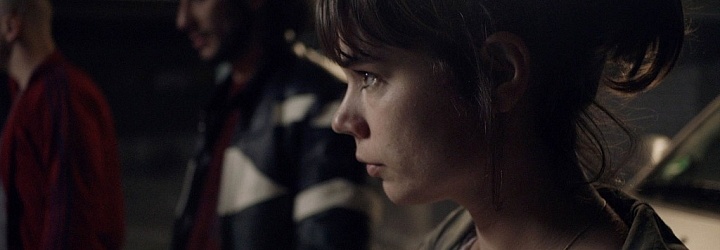Victoria (Laia Costa), a young Spanish woman recently arrived and alone in Berlin, meets four young men outside a nightclub. Sonne (Frederick Lau), Boxer (Franz Rogowski), Blinker (Burak Yiğit) and Fuß (Max Mauff) convince Victoria to join them for another drink before she heads to her early morning shift as a poorly-paid barista. They share alcohol and personal stories, and a particular bond forms between Victoria and Sonne. But what initially appears to be a film about a budding romance abruptly shifts generic gears when Boxer is called on to repay his debts to a local gangster (André Hennicke). He has until daybreak to rob a nearby bank or suffer the consequences. Victoria is enlisted as the driver, and the night escalates into a perilous series of events. Soundtrack by Nils Frahm.
Shot in a single 140-minute take in 22 locations, Victoria caused a stir at the Berlinale premiere for its remarkable technical achievement. Demanding extraordinary stamina and precision from its cameraman and cast, Sebastian Schipper’s real-time experiment has been regarded as a challenge to contemporary cinema to exchange finished scripts and post-production fine-tuning for more improvisational and physically intense approaches to filmmaking. The point, Schipper explains in interviews, was not the single take in itself, but the energy and risk-taking that the process required – elements that would be translated into gripping performances and cinematography.
The point was not the single take in itself, but the energy and risk-taking that the process required.
While praise for the film’s technical feats has been uniformly high, some reviewers—especially in the English-language press—have qualified this with criticisms of the film’s many perceived plot-holes: why would a girl risk her life for strangers? What trained police officer would really have allowed Victoria and Sonne to get away? How could two disheveled looking young people with no ID get a room at a luxury hotel? Some saw these questions of credibility as weaknesses that otherwise marred the film’s authenticity. But this is to confuse the exercise of shooting in real time with an attempt at documentary realism. There are far too many distancing effects, not least the gaps in plot, that refuse to allow the surface narrative to eclipse the more compelling undercurrents of the film. The actual robbery itself proves unspectacular: we never even see it since the camera remains with Victoria as she waits anxiously in the getaway-car. It is not the grand drama of the bank robbery that deserves our attention; it is the smaller moments, the little dramas – of friendship, first encounters, flirtations, rejection, remorse – that are most riveting. The heist plot is secondary, a vehicle to explore quieter themes, such as loneliness, solidarity, and precarity in a transnational Europe. Victoria and her new companions are all social and economic outsiders: Victoria is a foreigner who speaks no German, has made no friends, and works in a 4-Euro-per-hour job while Sonne and his pals loiter on the streets because they don’t have the money for anything else.
The figure of Victoria – a young Spaniard in Berlin – references a contemporary political and economic reality, reminding of the crisis that has brought many young Europeans to Berlin. Interestingly, though, Victoria’s backstory suggests that her particular case is different. In a key scene, Victoria reveals that she is a trained musician and astonishes Sonne with her performance of Liszt’s Mephisto Waltz. After years of study, Victoria’s hopes of a concert career were dashed when she was asked to leave the conservatory in Madrid. Her talent is not sufficient, the years of practice, sacrifice, discipline and isolation led only to failure and now she is looking to forget and start over in Berlin.
This particular detail creates another layer of meaning. While Victoria plays, Sonne is visibly moved; his childish joking gives way to seriousness as he tries to articulate the sensation unleashed by Victoria’s performance. When Sonne, finally at a loss for words, simply gestures outward from his heart, suggesting an indescribable response, we sense that it is not only his faltering English that prevents him from fully communicating what he is experiencing. Affect, emotion, connection – these are important themes in the film in which Victoria – the aimless, friendless Spaniard in Berlin – is emblematic for a zeitgeist in which desire often exceeds one’s individual possibilities and hypermobility leads not to opportunity and adventure but loneliness and ennui. FAZ critic Andreas Kilb is certainly correct that given its emphasis on this broader contemporary spirit, Victoria might have been filmed in another city. Nevertheless, Berlin’s confluence of long-time residents and recent arrivals, along with its status as international mecca for pleasure-seeking youth, makes it a particularly suitable location for reflections on contemporary youth culture. Similar themes of disillusionment and disconnection can for example be seen in Jan Ole Gerster’s recent Berlin film Oh Boy!
Victoria – the aimless, friendless Spaniard in Berlin – is emblematic for a zeitgeist in which desire often exceeds one’s individual possibilities and hypermobility leads not to opportunity and adventure but loneliness and ennui.
The fact that Victoria is a musician and that the bond between her and Sonne is cemented through artistic performance is also significant and marries the film’s content to its formal experiment: this is a film that above all aims to move its viewers, not with a thrilling story propped up with elaborate sets and special effects, but with thrilling performances intensified by the real-time approach in which we do not cut ahead in time and space for the economy of narrative and our perspective is limited to Victoria’s trajectory. At the same time, however, the film keeps us aware that what we are watching is illusion and artifice and it is on this level that the heist plot transcends banal generic convention and becomes a metaphor for the filmmaking process itself. In preparation for the bank robbery, gangster Andi insists that Boxer and his accomplices rehearse in an underground parking garage that has been marked out like a stage set to indicate the layout of the bank. After Boxer, Sonne and Blinker act out their entrance, wielding guns and shouting directions at imaginary bank employees, Andi cuts the scene and directs them on how to better perform their roles: only one person should speak, no shouting at the same time, the employees need to receive clear instructions. The references to stage, set, actors, directors, lines and audience suggest a risky performance, one that Boxer and his friends are terrified will end in disaster. In much the same way Sebastian Schipper and his cast have described the one-take project of Victoria as a risky venture where the potential to fail was a frightening possibility.


Pingback: Victoria is still making waves | kultur360